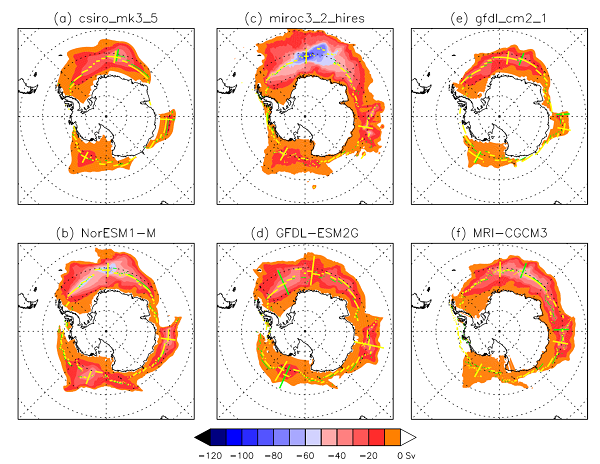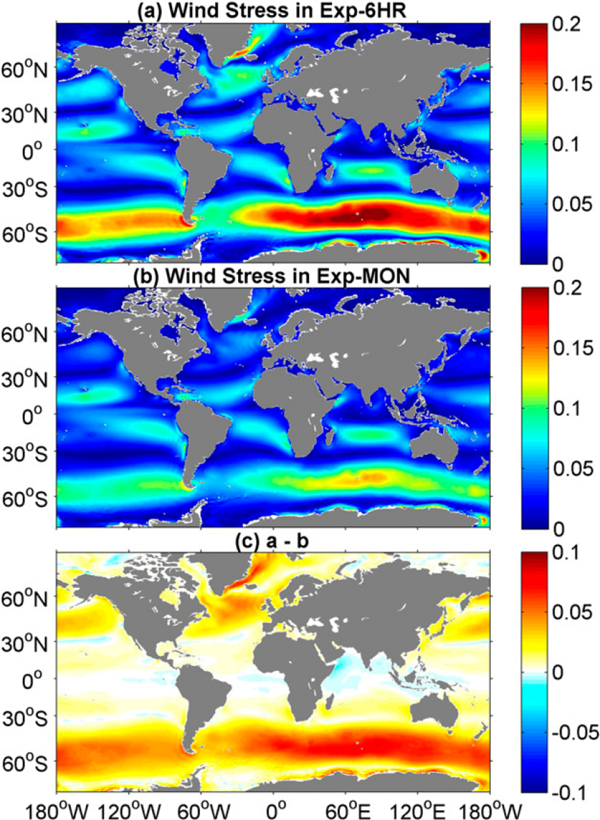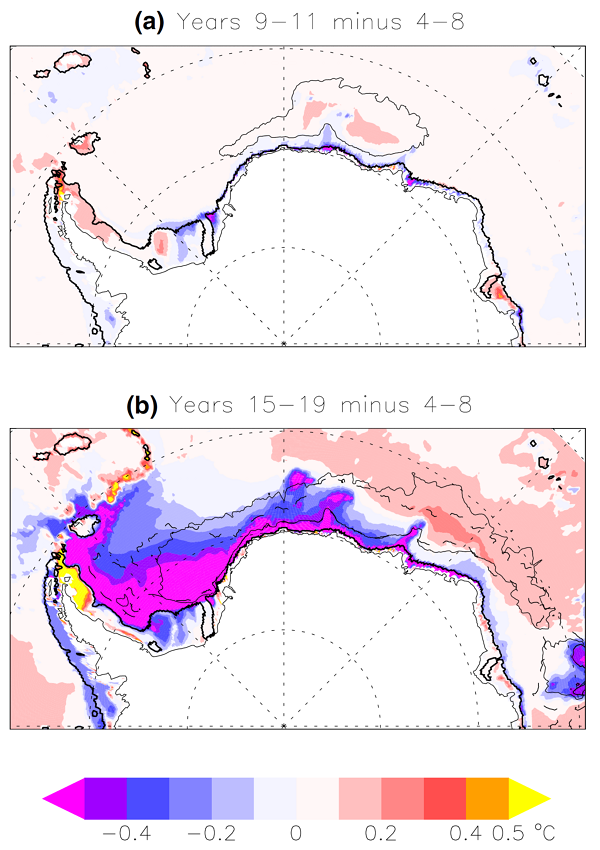



(Wang, Z. (2013), On the response of Southern Hemisphere subpolar gyres to climate change in coupled climate models, J. Geophys. Res. Oceans, 118, 1070–1086, doi:10.1002/jgrc.20111.)
Under increased greenhouse gas forcing, the Southern Hemisphere westerly winds consistently become intensified, resulting in increased cyclonic windforcing in the subpolar region in CMIP3 and CMIP5 models. Under such wind forcing changes, it is a robust feature that there are consistent increases in the westward flow close to the coast of Antarctica, with strong implications to the mass balance of the Antarctic ice shelves and ice sheets. However, there are large discrepancies in the responses of the gyre axes and overall gyre strengths. Some models show equatorward expansions of the southern gyre limbs, resulting in consistent and large gyre strength increases, while some other models show poleward contractions of the gyres and generally small and less consistent gyre strength changes. These uncertainties are primarily a result of the uncertain simulations of eddy-driven circulations in the Antarctic Circumpolar Current.

Figure 5. The averaged barotropic stream functions over the first two decades of the 21st century runs and gyre axes derived from these barotropic stream functions (green) and from those averaged over 2081–2100 (yellow) for the subpolar gyres. The north-south oriented ticks mark the subpolar gyre centers for the first two decades of the 21st century (green) and for 2081–2100 (yellow).
(Yang Wu, Xiaoming Zhai, Zhaomin Wang, Impact of Synoptic Atmospheric Forcing on the Mean Ocean Circulation, Journal of Climate, DOI: http://dx.doi.org/10.1175/JCLI-D-15-0819.1)
Including synoptic atmospheric forcing has led to a number of significant changes in a high resolution global ocean-sea ice model (MITgcm-ECCO2). For example, wind power input to the ocean increases by about 50%, which subsequently leads to a similar percentage increase in global eddy kinetic energy. The wind-driven subtropical gyre circulations are strengthened by about 10%–15%, whereas even greater increases in gyre strength are found in the subpolar oceans. Deep convection in the northern North Atlantic becomes significantly more vigorous, which in turn leads to an increase in the Atlantic meridional overturning circulation (AMOC) by as much as 55%. As a result of the strengthened horizontal gyre circulations and the AMOC, the maximum global northward heat transport increases by almost 50%. Results from this study show that synoptic atmospheric phenomena such as weather systems play a vital role in driving the global ocean circulation and heat transport, and therefore should be properly accounted for in paleo- and future climate studies.

Fig. 1. The magnitude of time-mean surface wind stress in (a) Exp-6HR (with synoptic wind fluctuations), (b) Exp-MON (without synoptic wind fluctuations), and (c) their difference.
(Zhaomin Wang, Yang Wu, Xia Lin, Chengyan Liu, Zelin Xie, Impacts of open-ocean deep convection in the Weddell Sea on coastal and bottom water temperature, Climate Dynamics, 2016, doi:10.1007/s00382-016-3244-y)
A high resolution global ocean–sea ice model (MITgcm-ECCO2) is employed to investigate the impacts of open-ocean deep convection on coastal and bottom water temperature in the Weddell Sea. The imposed strong and persistent cyclonic wind forcing and the large loss of bottom water weaken the stratification and eventually trigger the occurrence of openocean deep convection in the southern limb of the Weddell Gyre in this model. The production rate of the bottom water induced by the deep convection is estimated to be about 5 Sv (1 Sv = 106 m3/s) for a polynya with a similar size to that of the observed Weddell Polynya in the mid-1970s. The cooling induced by deep convection at mid-depth is transported towards the shelf regions by standing meanders or eddies to affect the basal melting of ice shelves, and is transported westward by an intensified slope current; interior coastal temperature in regions with a broader continental shelf is less affected by the deep convection, as the intensified slope current acts to suppress heat exchanges across the shelf break. Also, the deep convection causes warming in the Weddell bottom water around the convection site, when the simulated polynya size is similar to that of the observed Weddell Polynya in the mid-1970s. This finding sheds light on the observed non-monotonic decadal change (cooling between 1984–1992 and warming between 1998–2008) in the Weddell bottom water temperature.

Fig. 12 Ocean bottom temperature change. a Difference between the averages over years 9–11 and over years 4–8 with the mixed layer depth of 1500 m in September of year 11 (thin solid line) overlaid; b
Difference between the averages over years 15–19 and over years 4–8 with the mixed layer depth of 1500 m in September of year 16 (thin solid line) and year 19 (thin dashed line) overlaid. The 500 m isobaths (thick black line) is used to separate the shelf region from the open ocean region
© 2014 Mokaine. All Rights Reserved.More Templates - Collect from
Lorem ipsum dolor sit amet, consectetur adipisicing elit, sed do eiusmod.